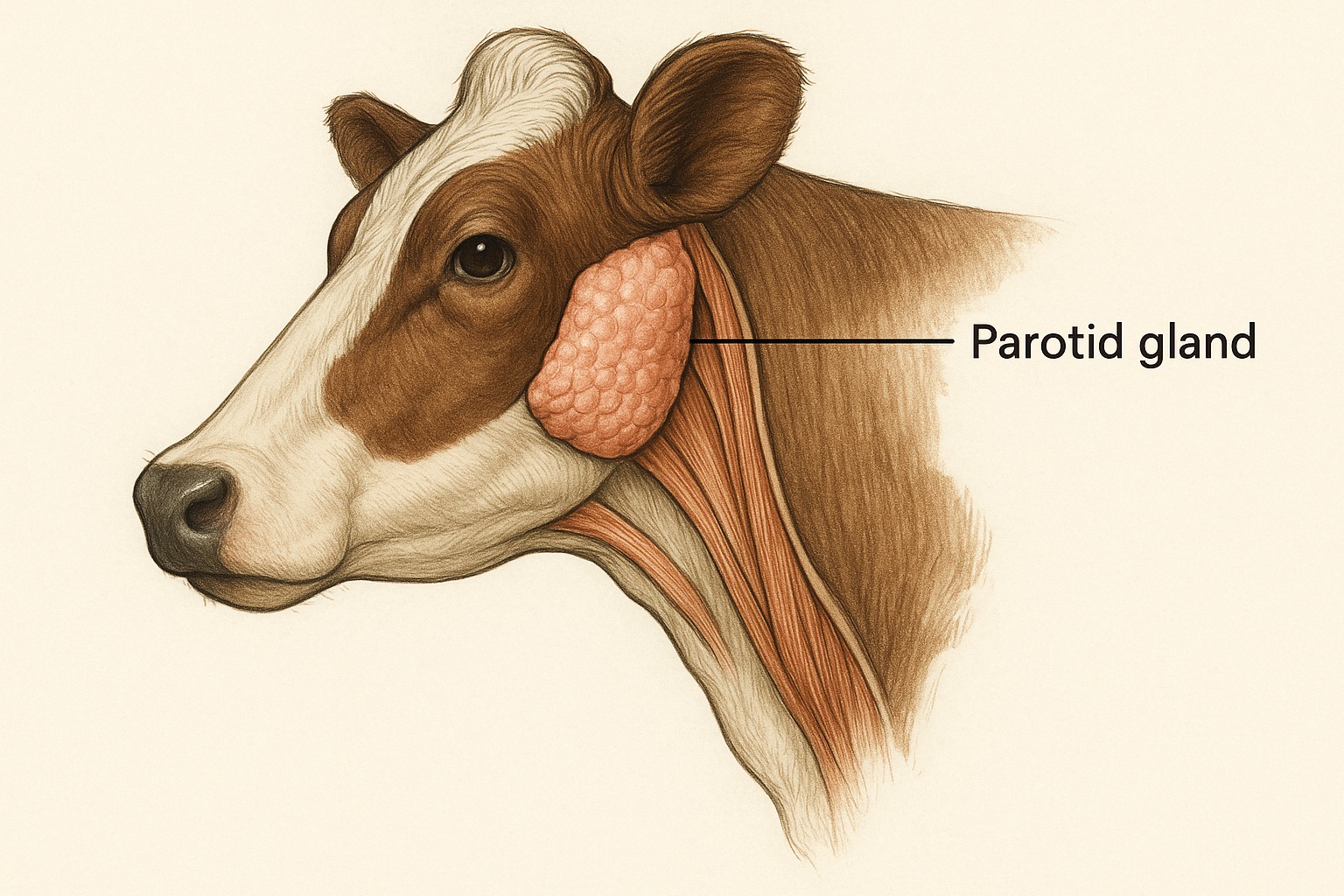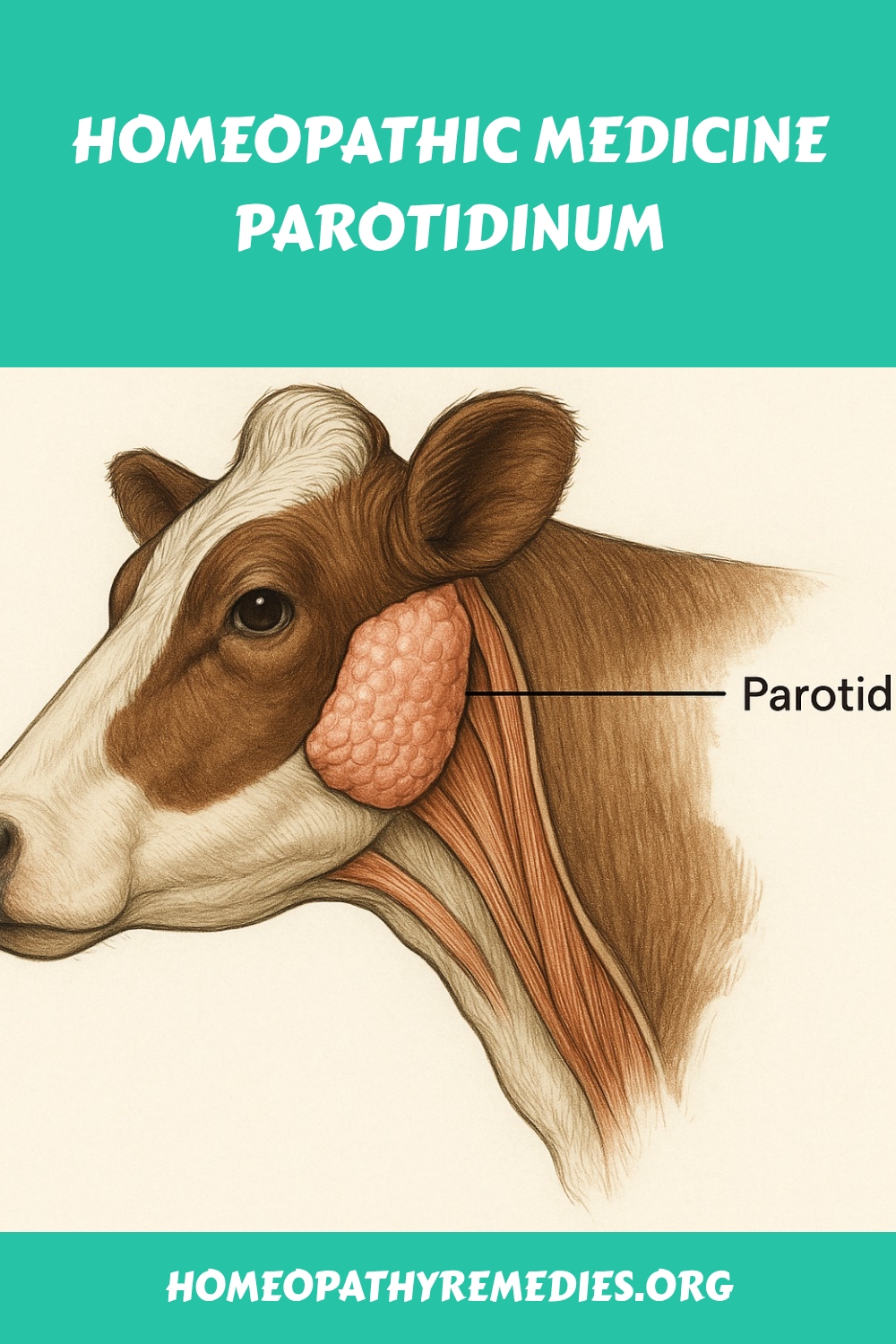A Comprehensive Guide to Homeopathic Medicine Parotidinum
Introduction
Homeopathy is a holistic system of medicine that uses highly diluted natural substances to stimulate the body’s self-healing mechanisms. One such remedy, Parotidinum, is derived from the diseased parotid gland of mammals, primarily used to treat conditions related to glandular swellings, mumps, and other systemic imbalances. This article explores the origin, preparation, potencies, symptoms, uses, side effects, preventive aspects, case studies, and comparisons of Parotidinum with other remedies.
Origin and Extraction of Parotidinum
Parotidinum is prepared from the pathological secretion of the parotid gland, typically obtained from animals suffering from mumps or parotitis. The parotid gland is one of the major salivary glands located near the ears, and its infection leads to painful swelling, a hallmark of mumps.
Preparation Process
-
Source Material: The diseased glandular tissue or secretion is collected.
-
Trituration or Dilution: The substance undergoes serial dilution and succussion (vigorous shaking) as per homeopathic pharmacopeia standards.
-
Potentization: The final product is available in various potencies, such as 6C, 30C, 200C, and 1M, where higher dilutions are believed to have deeper therapeutic effects.
Potencies and Dosage
Parotidinum is available in multiple potencies, each suited for different conditions:
-
6C to 30C: Used for acute conditions like mumps, glandular swellings, and fever.
-
200C to 1M: Prescribed for chronic glandular disorders or preventive care during mumps outbreaks.
Dosage Guidelines:
-
Acute cases: 3-5 drops or pellets every 2-4 hours until symptoms improve.
-
Chronic cases: Once or twice daily for a few weeks.
-
Prophylaxis: Once a week during epidemics.
Symptoms and Indications for Use
Parotidinum is primarily indicated for conditions involving glandular inflammation, lymphatic swellings, and viral infections. Key symptoms include:
1. Mumps (Epidemic Parotitis)
-
Painful swelling of the parotid glands (near the ears).
-
Difficulty in chewing and swallowing.
-
Fever, headache, and malaise.
2. Lymphatic Disorders
-
Swollen lymph nodes, especially in the neck and groin.
-
Tenderness and heat in the affected glands.
3. Reproductive System Afflictions
-
Orchitis (swelling of testes in males).
-
Oophoritis (ovarian inflammation in females).
4. Secondary Complications
-
Pancreatitis (abdominal pain, nausea).
-
Meningitis (severe headache, neck stiffness).
Clinical Uses of Parotidinum
1. Treatment of Mumps
Parotidinum is highly effective in reducing swelling, pain, and fever associated with mumps. It may also prevent complications like orchitis if given early.
2. Glandular Fever and Lymphadenopathy
It helps in cases of mononucleosis (glandular fever) where lymph nodes remain enlarged for prolonged periods.
3. Autoimmune and Chronic Inflammatory Conditions
Some homeopaths use it in autoimmune disorders where glandular dysfunction is prominent, such as Sjögren’s syndrome (dry mouth due to salivary gland inflammation).
Side Effects and Safety
Being a highly diluted remedy, Parotidinum is generally safe with no known severe side effects. However, in rare cases:
-
Aggravation of symptoms (temporary worsening before improvement).
-
Allergic reactions (if alcohol-based tinctures are used in sensitive individuals).
Precautions:
-
Avoid self-prescribing high potencies (200C and above) without professional guidance.
-
Discontinue if unusual symptoms appear and consult a homeopath.
Preventive Use of Parotidinum
During mumps outbreaks, Parotidinum can be used as a prophylactic (preventive) measure:
-
Dosage: 200C once a week for 3-4 weeks.
-
Effectiveness: Anecdotal evidence suggests reduced susceptibility, though scientific validation is limited.
Case Studies and Clinical Evidence
Case Study 1: Mumps with Orchitis
A 12-year-old boy presented with bilateral parotid swelling, high fever, and testicular pain. Parotidinum 30C was administered every 3 hours. Within 24 hours, the swelling reduced, and fever subsided. By the third day, testicular pain vanished completely.
Case Study 2: Chronic Lymphadenopathy
A 35-year-old woman had persistent cervical lymph node enlargement post-viral infection. Parotidinum 200C (twice daily for a month) showed significant reduction in node size and improved immunity.
Comparison with Other Homeopathic Remedies
1. Parotidinum vs. Belladonna
-
Belladonna: Best for sudden, intense inflammation with redness, heat, and throbbing pain.
-
Parotidinum: More specific for glandular swellings, especially mumps.
2. Parotidinum vs. Merc Sol
-
Merc Sol: Useful for excessive salivation, foul breath, and ulcerations alongside glandular swellings.
-
Parotidinum: Focuses more on viral parotitis and lymphatic involvement.
3. Parotidinum vs. Phytolacca
-
Phytolacca: Indicated for hard, stony glands (e.g., breast lumps, thyroid nodules).
-
Parotidinum: Better for soft, inflamed glands like in mumps.
Frequently Asked Questions (FAQs) About Homeopathic Medicine Parotidinum
1. What is Parotidinum in homeopathy?
Parotidinum is a homeopathic remedy prepared from the diseased parotid gland (a salivary gland) of mammals, typically sourced from animals infected with mumps (parotitis). It is used to treat glandular swellings, mumps, and related inflammatory conditions.
2. How is Parotidinum made?
The remedy is prepared through homeopathic potentization, where the glandular extract undergoes serial dilution and succussion (vigorous shaking). This process enhances its therapeutic properties while minimizing toxicity.
3. What conditions does Parotidinum treat?
Parotidinum is primarily used for:
-
Mumps (parotitis) – Reduces swelling and pain in the parotid glands.
-
Swollen lymph nodes – Helps in cases of lymphadenopathy.
-
Orchitis & oophoritis – Treats testicular or ovarian inflammation.
-
Preventive care – Used during mumps outbreaks to reduce susceptibility.
4. What are the common potencies of Parotidinum?
It is available in different potencies, including:
-
6C, 12C, 30C – For acute conditions like mumps.
-
200C, 1M – For chronic glandular issues or preventive use.
5. How should I take Parotidinum?
-
For acute mumps: Take 3-5 pellets of 30C every 2-4 hours until symptoms improve.
-
For prevention: 200C once a week during an outbreak.
-
Always consult a qualified homeopath for personalized dosage.
6. Can Parotidinum prevent mumps?
Yes, it is often used prophylactically (as a preventive measure) during mumps outbreaks. A common protocol is 200C once weekly for 3-4 weeks to boost resistance.
7. Are there any side effects of Parotidinum?
Since homeopathic remedies are highly diluted, side effects are rare. However, some individuals may experience:
-
Temporary aggravation of symptoms before improvement.
-
Mild allergic reactions (if sensitive to alcohol-based dilutions).
8. Can Parotidinum be taken with conventional medicine?
Yes, homeopathic remedies generally do not interfere with allopathic medicines. However, it’s best to consult a healthcare provider to avoid potential interactions.
9. How does Parotidinum compare to Belladonna or Merc Sol for mumps?
-
Belladonna – Best for sudden, high fever with red, hot, throbbing swelling.
-
Merc Sol – Used when there is excessive salivation, foul breath, and pus formation.
-
Parotidinum – Specifically targets glandular swelling in mumps and prevents complications like orchitis.
10. Is Parotidinum safe for children?
Yes, it is safe for children when used in appropriate potencies (e.g., 6C or 30C). It is commonly prescribed for pediatric mumps and glandular issues.
11. How long does Parotidinum take to work in mumps?
In acute cases, improvement is often seen within 24-48 hours (reduced swelling, pain, and fever). Chronic glandular conditions may require longer treatment.
12. Can Parotidinum help with chronic lymph node swelling?
Yes, in cases of persistent lymphadenopathy, higher potencies like 200C may be prescribed to reduce inflammation and support lymphatic drainage.
13. Where can I buy Parotidinum?
It is available at:
-
Homeopathic pharmacies (online or in-store).
-
Practicing homeopaths (who may prescribe customized potencies).
14. Does Parotidinum have any scientific backing?
While traditional homeopathic literature supports its use, more clinical studies are needed for scientific validation. However, many homeopaths report success in treating mumps and glandular disorders.
15. Can I take Parotidinum for thyroid swelling?
It is not the primary remedy for thyroid disorders. However, if swelling is due to lymphatic or glandular involvement, a homeopath may consider it alongside other remedies like Iodum or Calcarea fluorica.
Conclusion
Parotidinum is a valuable homeopathic remedy for glandular disorders, particularly mumps, lymphadenopathy, and reproductive gland inflammations. Its prophylactic use in epidemics and ability to prevent complications make it a versatile choice. While generally safe, professional guidance is recommended for optimal results. Further clinical studies could enhance its validation in modern medicine.
By understanding its origin, symptoms, potencies, and comparisons, homeopaths and patients can utilize Parotidinum effectively in both acute and chronic conditions. Its role in holistic healing underscores the importance of homeopathy in managing glandular and systemic diseases naturally.


